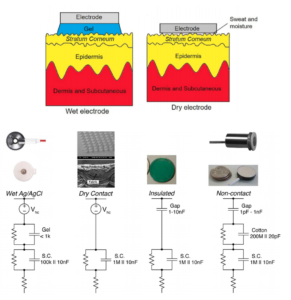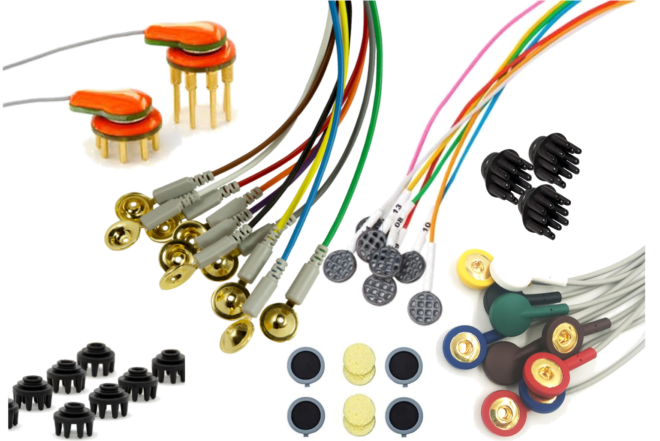EEG recording technology remains similar in principle since its first use in 1923. However, a vast array of electrode types, both wet and dry, are now available. What are some of the the key differences?
A brief history of EEG electrodes
The first electroencephalography (EEG) recordings from a human brain were done by Hans Berger, a German physicist, in 1923. In these first recordings Berger used silver wires inserted under the scalp of the patient as EEG electrodes and later switched to silver foil electrodes, that were stuck to the subject’s head with a bandage. He used a rather primitive string Galvanometer to record the EEG from these electrodes, eventually switching to a double-coil Siemens recording galvanometer, which allowed him to record EEG as small as 0.1 millivolts. This was almost a century ago. Today, although we no longer ‘stick’ individual electrodes to the subject’s head, we now have a number of different types of electrodes to choose from. On the other hand the basic procedure of routine EEG in clinics and research has barely changed.
What kind of EEG electrodes are used today? How has EEG evolved as a technology? What are dry, wet, active and passive electrodes? Which electrode type to use?
Wet/Gel electrodes
Electrode-skin impedance is an important factor that determines the electrical properties of the electrode-skin interface. The lower the electrode-skin impedance, the better will be the quality of EEG signals. Also, low electrode-skin impedance can help to reduce the power line interference and also make EEG signals more immune to movement artifacts, including cable motion. Today, the most commonly used electrode is the silver/silver chloride (Ag/AgCl) electrode. Ag/AgCl electrodes, also referred to as wet electrodes, use an electrolyte gel to form a conductive path between skin and electrode to reduce the electrode-skin impedance. Wet electrodes are the current gold standard in clinical practice, however they have several disadvantages,
- It may take a long time to reduce the impedance to an acceptable value (5–20 KΩ).
- Once acceptable impedance is reached, the gel may dry up in a few hours, again increasing the impedance. For example, it was observed that the impedance of wet electrodes deteriorated from 5 to 15 KΩ within 5 hours after gel application. Thus, wet electrodes are not suitable for long-term EEG.
- Usage of many electrodes (i.e., dense array EEG) can also be problematic, because the distance between electrodes reduces as the number of electrodes increase. This can cause the electrolyte gels to form a conductive bridge between two electrodes.
- Setting up the EEG with wet electrodes is time consuming (skin preparation, waiting for impedance to reach acceptable value etc.) and requires a professional.
- Finally, the usage of abrasive paste (as part of scalp preparation) and the electrolyte gel might be inconvenient for the subject.
Dry Electrodes
Dry electrodes (See Figure 1) are proposed as an alternative solution for stable long-term EEG recordings and to overcome the common issues with wet electrodes highlighted above. One of the main advantages of dry electrodes is that, unlike wet electrodes, they do not require laborious scalp preparation and hence are less time consuming. Dry electrodes can be broadly classified into contact, noncontact and insulating electrodes. In a contact dry electrode, the scalp is in direct contact with the electrode surface, which consists of a metallic array of spikes. In some cases, the electrode can even be pierced into the stratum corneum (SC), to achieve mechanical stability as well as better electrical property. In a noncontact dry electrode, the bottom plate is made of metal, which is capacitively coupled through an insulator such as hair or clothing. In the case of an insulated electrode, as the name suggests, the bottom plate of an electrode is an insulation material and also works on the basis of capacitive coupling. In EEG applications, dry contact electrodes are more commonly used as they have somewhat lower impedance compared to the other two types.

Figure 1 : An example of a contact, insulating and noncontact dry electrode [1,2].
The electrical model of the electrode-skin interface is shown in the figure below. As it can be seen, introduction of a conductive gel is modelled as a resistive-capacitive circuit (with impedance < 1KΩ), whereas, the electrical impedance between a dry electrode and the skin (SC – stratum corneum) is higher due to the absence of the gel.

Figure 2 : The electrical model of the various electrode-skin interface [3.5].
However, dry electrodes are not without their share of problems. Firstly, due to the absence of a conductive layer and thus increased impedance (as high as a few MΩ at 50/60 Hz), a significant amount of noise and interference is observed in the EEG, with a greater prevalence of movement artifacts. Dry electrodes thus need to be shielded to minimize noise due to interference. Connecting dry electrodes directly to an EEG amplifier using non-shielded cables (passive electrodes) will not ensure good signal quality. Instead, active electrodes, which amplify the EEG at the scalp and thus decrease the influence of environmental noise are needed. This also reduces the need for shielded cables to maintain the signal quality, which is an attractive feature for compact wearable devices. Further, the spiky electrodes can be quite uncomfortable and cannot be worn for long periods of time.
In the next blog we will look at some EEG studies that have compared these two electrode types. Which ones to use may depend substantially on the goals of use and the specific compromises that one is willing to make.
References
References
- Oehler, Martin, et al. “Extraction of SSVEP signals of a capacitive EEG helmet for human machine interface.” 2008 30th Annual International Conference of the IEEE Engineering in Medicine and Biology Society. IEEE, 2008.
- Chi, Yu Mike, et al. “Dry and noncontact EEG sensors for mobile brain–computer interfaces.” IEEE Transactions on Neural Systems and Rehabilitation Engineering 20.2 (2011): 228-235.
- Chi, Yu Mike, Tzyy-Ping Jung, and Gert Cauwenberghs. “Dry-contact and noncontact biopotential electrodes: Methodological review.” IEEE reviews in biomedical engineering 3 (2010): 106-119.
- Xu, Jiawei, et al. Low power active electrode ICs for wearable EEG acquisition. Berlin, Germany: Springer, 2018.
- Li, Guangli, Sizhe Wang, and Yanwen Y. Duan. “Towards gel-free electrodes: A systematic study of electrode-skin impedance.” Sensors and Actuators B: Chemical 241 (2017): 1244-1255.
















